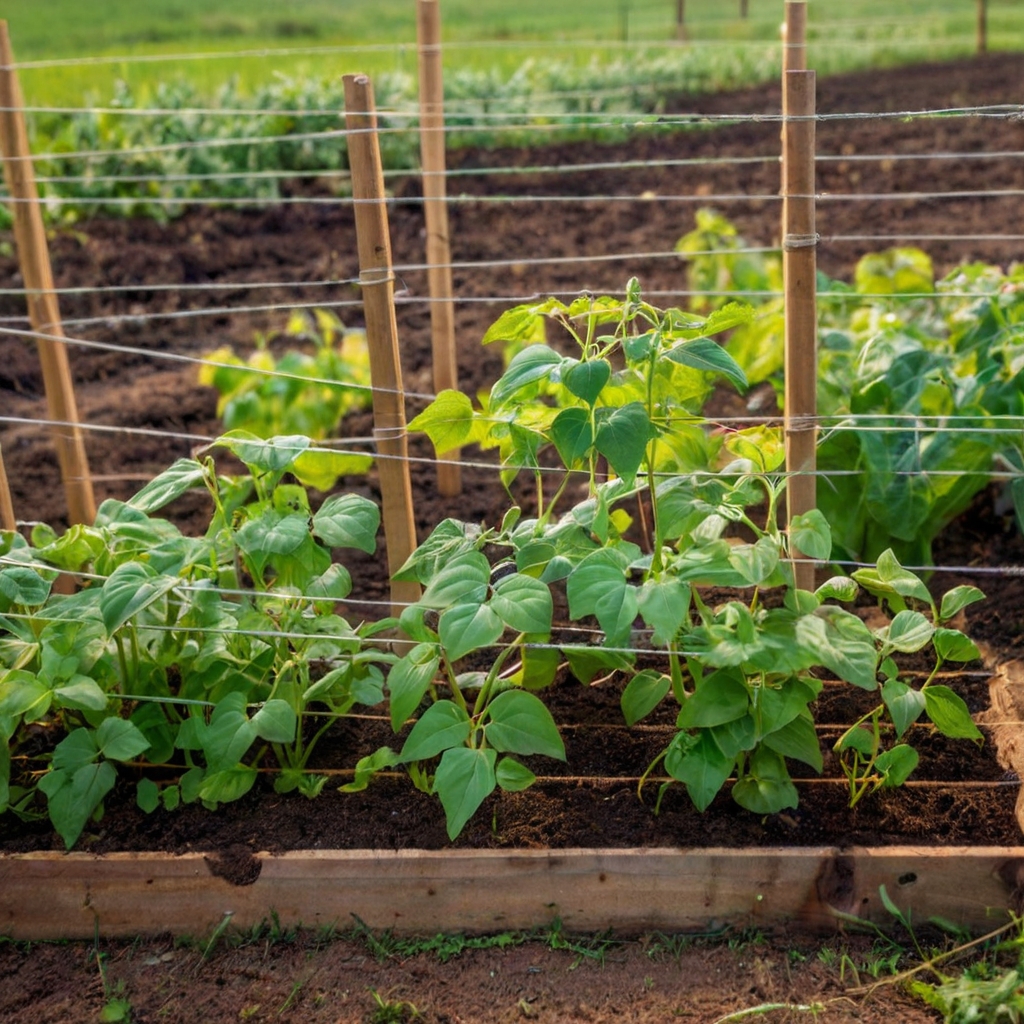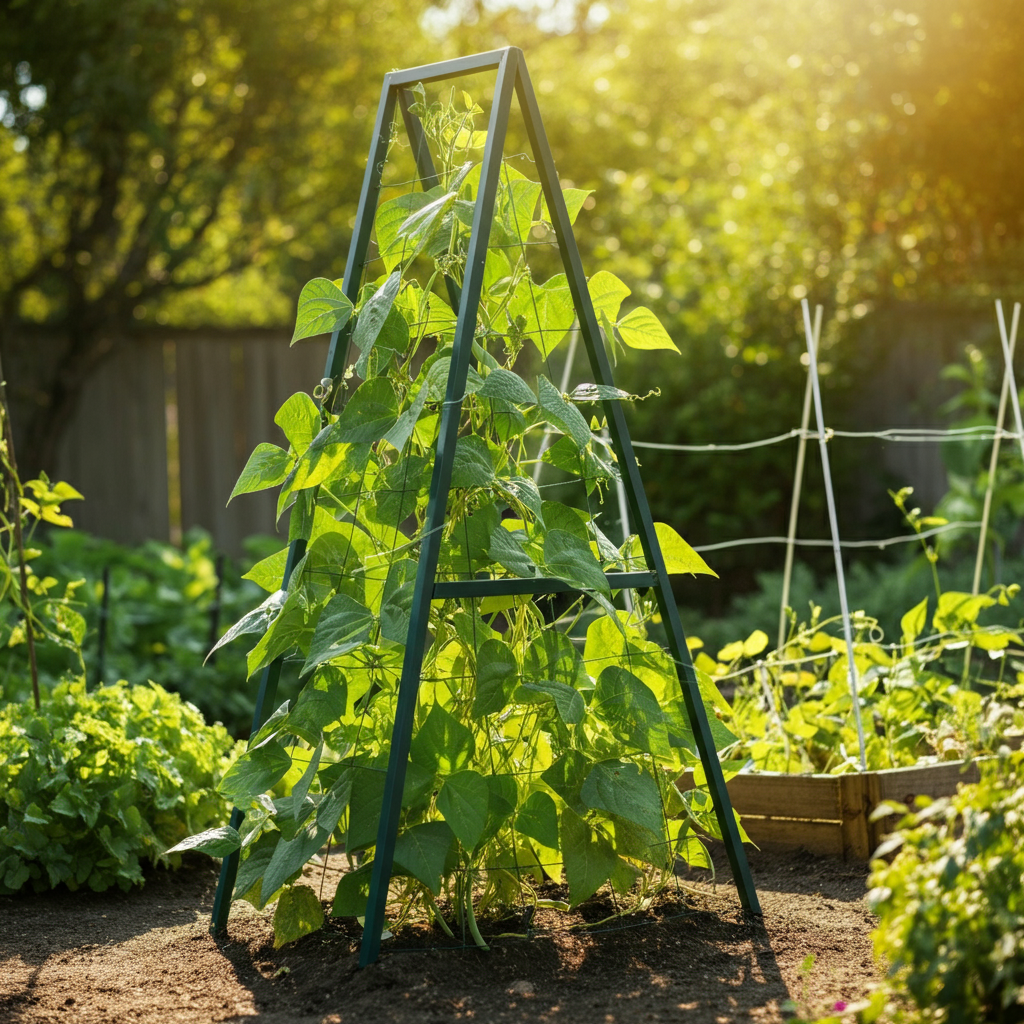Green beans are a garden darling for their crisp texture, sweet flavor and versatility in the kitchen. But growing them to reach their full potential? That’s where a trellis comes in. A green bean trellis provides support for your plants, maximizes yield and makes your gardening life so much easier—all while adding a vertical touch of charm to your green space.
This guide explains the hows and whys of trellising green beans if you’re curious. You’ll learn everything from choosing the right design to building your trellis and caring for your beans, so that you can grow a thriving trellis garden.
What is a Green Bean Trellis?
Definition and Purpose
A green bean trellis is a basic, but important structure to support climbing bean plants as they grow. These can take the form of A-frames, teepees, or vertical panels, all of which have their advantages based on your garden layout. A trellis will promote healthy growth, as green beans will climb upward toward the trellis, allowing air to circulate through the plants and minimizing the risk of disease. It also helps with harvesting and optimizes your garden space, making it the perfect fit for smaller gardens or those who want to produce large yields in limited space. This makes it an essential fixture for vegetable gardeners aiming to give earth-friendly support and structure to your growing environment.
Benefits of Green Bean Trellising
- Better Growth: This aids plant to grow up, in turn ensuring they receive an optimal amount of sunlight.
- Efficient Harvesting: With the beans growing on the vine, they’re easier to harvest.
- Improved Health: There is less disease and pest problems with good air flow around the plants.
- Space Saving: Growing vertically saves garden space, enabling you to cultivate more plants in a compact area.
- Enhanced Yield: Trellised plants generally result in more beans as the plants flourish.
- Cleaner Produce: Hanging on the ground, beans become cleaner and with low soil splash when raining or watering.
- Aesthetic Appeal: Not only do we benefit from the vines producing beans, but a green bean trellis provides a vertical focal point in your garden that adds character and dimension.
Why Trellising is Essential for Green Beans
Maximizing Growth Potential
Well, the very best green bean plants, which are pole beans, are climbers by nature! A trellis provides them the vertical space to grow instead of sprawling across your garden bed. Not only does this keep your plants organized, it also helps them make healthier leaves and beans.
Enhancing Harvest Quality and Quantity
Trellising keeps the bean pods off the ground, reducing the risk of rot or damage from pests. The result? Healthier, cleaner produce, and a generally more bountiful harvest.
Understanding Green Beans
Pole Beans vs. Bush Beans
- Pole Beans: These are climbing beans that really love a trellis. They grow tall and start producing beans all through the growing season.
- Bush Beans: Compact and low-growing, bush beans don’t require a trellis, but they can benefit from some support to keep them from tipping over as they mature.
Best Varieties for Trellising
Some pole bean varieties include Kentucky Wonder, Blue Lake, and Scarlet Runner beans, which each has unique characteristics. Kentucky Wonder is an old standby known for its flavorful and tender pods. Blue Lake is a favorite for producing heavy yields of crisp beans, ideal for fresh eating or for canning. Scarlet Runner beans not only produce good crop yields, they also have beautiful red flowers that look decorative in your garden. Sow fast-growing climbing beans on a trellis, and they will reach great heights, producing many beans over the growing season.
Natural Growth Habits
Pole beans have a natural tendency to climb things, so a trellis is the perfect structure to help them grow up instead of out. As the vines will naturally climb towards something to grab hold of, some slight training is all that’s needed before they beautifully twist around the framework. This approach not only helps in saving space in your garden but also promotes better airflow around the plants, reducing the chances of diseases. And when the beans hang down from the elevated vines, harvesting is a lot easier. With a healthy pole trellis your pole beans will flourish and bless you with an abundant healthful harvest.
The Benefits of Using a Green Bean Trellis
Improved Plant Health
- Better Air Circulation: Training vines on a trellis encourages better airflow, reducing moisture retention and the potential for disease.
- Healthier Growth: By lifting vines and pods off the ground, you allow them to grow without competing with weeds.
Ease of Harvesting
- Accessible Growth: Beans on a trellis grow at eye level, so harvesting is easier on your back and knees.
- Cleaner Produce: Because the pods grow off the ground, they are less prone to showing dirt or mud.
Space Optimization
Vertical gardening involves growing this same crop in trellises or on walls and buildings, which is great for gardeners with limited space. Through the process of growing up instead of out, you create maximum use of limited space while also yielding a fantastic return.
Planning Your Green Bean Trellis
Choosing the Right Location
- Sunlight Requirements: Green beans are sun lovers, choose a spot to grow green beans that receives at least 6-8 hours of sunlight per day.
- Soil and Drainage: The soil should be loose, well-drained and rich in nutrients to promote healthy growth.
Determining the Best Trellis Design
- A-Frame Trellis: Good support and optimal fruit harvesting.
- Teepee Trellis: Functional, space-saving, looks good.
- Vertical Panels: Space saving for rows of beans, great for larger gardens.
Building Your Green Bean Trellis
Materials You’ll Need
- Using bamboo poles or wooden stakes.
- To make it durable, synthetic materials, PVC pipes, or steel panels.
Step-by-Step Guide to a DIY Trellis
1. A-Frame Trellis
- Materials: Two sturdily joined wooden panels and strong twine or netting.
- Assembly Steps:
1) Build two wooden frames with, vertical and horizontal supports
2) Secure netting or twine to the frames.
3) Lean the panels together in an “A” shape and anchor them into the ground.
2. Teepee Trellis
- Materials: Bamboo poles or garden stakes; twine
- Assembly Steps:
1) Tie twine where the tops of the poles come together, forming a cone.
2) Spread the ends of the poles down into the ground to help stabilize them.
3. Vertical Panel Trellis
- Materials: Metal or wooden panels, stakes and fasteners.
- Assembly Steps:
1) Stake it vertically into the ground.
2) Use fasteners to secure it in place.
Planting and Caring for Green Beans on a Trellis
Planting Green Bean Seeds
- Spacing: Sow seeds in the soil 2–4 inches apart.
- Germination Tips: Until seeds sprout keep the soil just moist.
Training Bean Plants to Climb
- Loosely tie young vines to the trellis framework.
- Use soft ties if required, but take care not to hurt the plant.
Maintenance Tips for Your Green Bean Trellis
Regular Inspections
- Look for damage or loose ties.
- Keep tightening up or replacing twine as needed to prevent collapse.
Pruning and Care
- Clearing away dead leaves allows for healthy growth and deters pests.
- Trellis is also used for evenly distributing vines.
Preparing for the Harvest
- Seek out beans for when they’re firm and crisp but not overripe.
- Regularly join the queue for encouraging continuous production.
Why Trellising Will Transform Your Garden

Trellising green beans is less of a technique than it is an art. It encourages healthier plants, easier harvesting, and better use of space. Photograph by David Frenkiel, courtesy of Green Kitchen Stories Plus, a trellised green bean garden adds beauty and vertical interest to your outdoor space.
Whether you’re a gardening pro or just getting started, making and using a bean trellis is a satisfying project that yields delectable, home-grown harvests.
Feeling inspired? The Trellis for your Dreams, build it now.
FAQ
Do I need a trellis for all types of green beans?
The answer is no, not all green beans need a trellis. Bush beans are compact and don’t usually need any type of support while pole beans grow tall and greatly benefit from trellising to support their climbing vines.
What materials can I use to build a trellis?
You can use all kinds of things: wood, bamboo, metal, or even strong twine. The important thing is to make sure the structure has enough strength, stability and load-bearing capacity to hold the weight of mature plants.
How tall should my trellis be?
The trellis for pole beans should be at least 6-8 feet tall to support their vigorous climbing behavior. For smaller spaces or different varieties, you can adapt to the needs of your garden.
Do trellised beans require special care?
Trellised beans require all the same basic care as conventional green beans, including adequate watering, sunlight, and nutrient-dense soil. But you may need to encourage young vines onto the trellis to get them started climbing.
Can I reuse my trellis next year?
Yes! A quality trellis can last for several seasons with proper maintenance and storage. Do clean it after the growing season to prevent diseases and pests from transferring.

